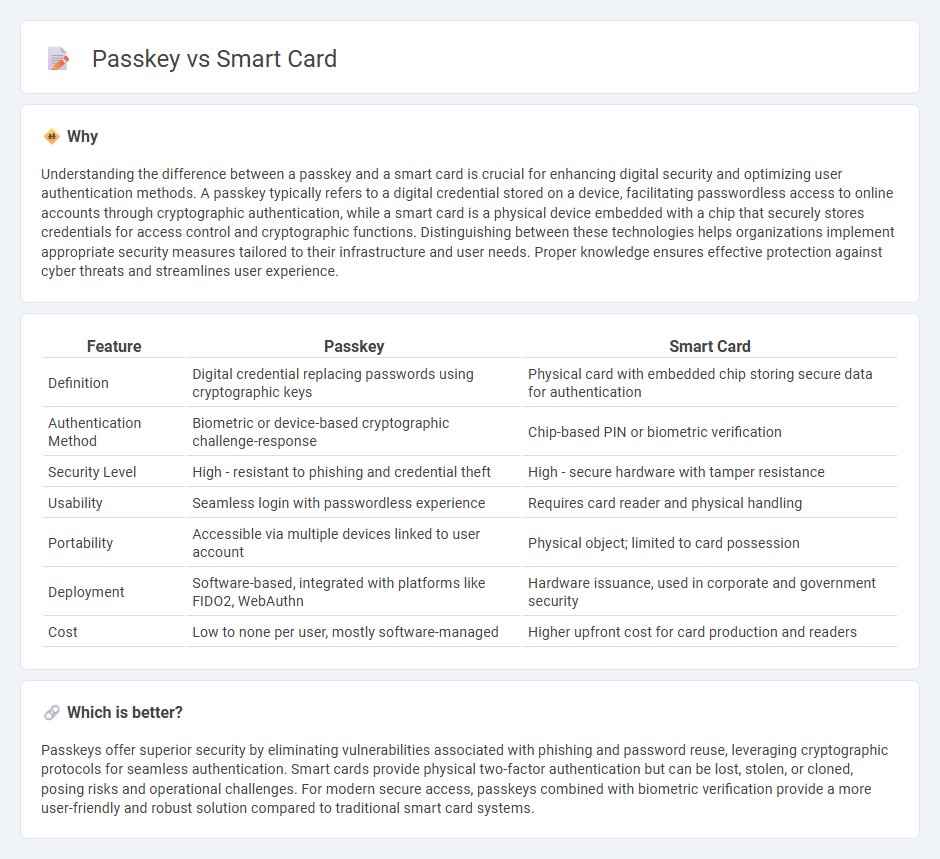
Passkeys offer a modern, convenient alternative to traditional smart cards by leveraging biometric authentication and encrypted digital credentials for secure access. Unlike smart cards that require physical hardware and card readers, passkeys enable seamless, passwordless login experiences across devices and platforms. Discover how these innovations are transforming digital security and access management.
Why it is important
Understanding the difference between a passkey and a smart card is crucial for enhancing digital security and optimizing user authentication methods. A passkey typically refers to a digital credential stored on a device, facilitating passwordless access to online accounts through cryptographic authentication, while a smart card is a physical device embedded with a chip that securely stores credentials for access control and cryptographic functions. Distinguishing between these technologies helps organizations implement appropriate security measures tailored to their infrastructure and user needs. Proper knowledge ensures effective protection against cyber threats and streamlines user experience.
Comparison Table
| Feature | Passkey | Smart Card |
|---|---|---|
| Definition | Digital credential replacing passwords using cryptographic keys | Physical card with embedded chip storing secure data for authentication |
| Authentication Method | Biometric or device-based cryptographic challenge-response | Chip-based PIN or biometric verification |
| Security Level | High - resistant to phishing and credential theft | High - secure hardware with tamper resistance |
| Usability | Seamless login with passwordless experience | Requires card reader and physical handling |
| Portability | Accessible via multiple devices linked to user account | Physical object; limited to card possession |
| Deployment | Software-based, integrated with platforms like FIDO2, WebAuthn | Hardware issuance, used in corporate and government security |
| Cost | Low to none per user, mostly software-managed | Higher upfront cost for card production and readers |
Which is better?
Passkeys offer superior security by eliminating vulnerabilities associated with phishing and password reuse, leveraging cryptographic protocols for seamless authentication. Smart cards provide physical two-factor authentication but can be lost, stolen, or cloned, posing risks and operational challenges. For modern secure access, passkeys combined with biometric verification provide a more user-friendly and robust solution compared to traditional smart card systems.
Connection
Passkeys and smart cards both enhance secure authentication by storing cryptographic credentials that verify user identity during access. Smart cards physically hold encrypted passkeys or digital certificates, enabling two-factor authentication for high-security environments. This integration ensures robust protection against unauthorized entry by combining something the user has (smart card) with something they know or biometrically possess (passkey).
Key Terms
Authentication
Smart card authentication relies on physical cards embedded with integrated circuits that store cryptographic keys, enabling secure access through contact or contactless readers. Passkey authentication uses cryptographic credentials stored on devices or in the cloud, offering passwordless and phishing-resistant login experiences. Discover how these technologies enhance security and transform digital authentication.
Encryption
Smart cards utilize hardware-based encryption with embedded cryptographic keys stored securely on the card, providing robust protection against unauthorized access and tampering. Passkeys rely on asymmetric encryption involving private-public key pairs stored on devices and servers, enhancing user authentication without transmitting sensitive information. Explore the nuances of encryption methods in smart cards and passkeys to understand their security advantages better.
Contactless
Contactless smart cards use embedded microchips to securely store and transmit data via radio frequency identification (RFID) technology, enabling quick, tap-to-pay or access functions without physical contact. Passkeys, leveraging cryptographic protocols, offer enhanced security for contactless authentication by replacing traditional passwords with asymmetric key pairs stored on devices, minimizing phishing risks. Discover more about how contactless smart cards and passkeys revolutionize secure transactions and access management.
Source and External Links
What is a Smart Card? 2025 Guide - Ramp - A smart card is a physical card with a built-in memory chip that electronically transfers data for identity verification, access authentication, and secure payments, available in both contact and contactless forms.
What is smart card? | Definition from TechTarget - A smart card is a card-sized plastic or metal token with an embedded integrated chip that securely stores and processes data, often used for payment systems, authentication, and as a replacement for magnetic stripe cards.
Smart card - Wikipedia - Smart cards are multi-function plastic cards with embedded microprocessors, offering secure access control, data storage, and encryption, with advantages like portability, high security, and resistance to electromagnetic interference.
 dowidth.com
dowidth.com